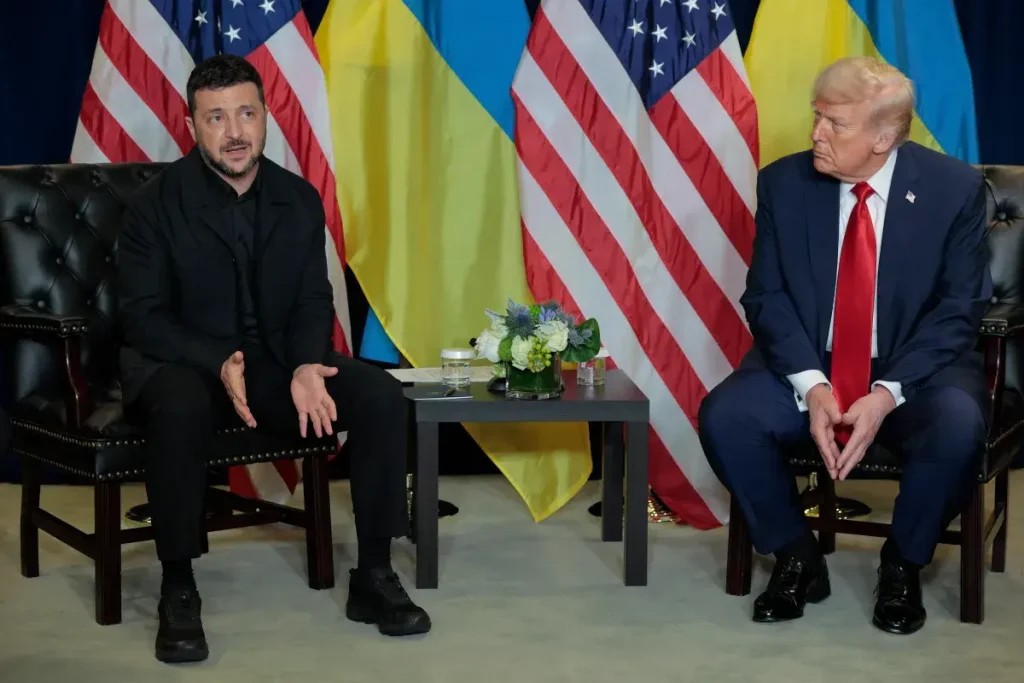Zelensky Seeks Tomahawk Missiles in White House Meeting with Trump
In a pivotal diplomatic moment, Ukrainian President Volodymyr Zelensky is meeting with President Donald Trump at the White House today, hoping to secure long-range Tomahawk missiles for Ukraine’s military arsenal. This request comes at a delicate time, just one day after Trump spoke with Russian President Vladimir Putin, who explicitly objected to such weapons transfers. The timing of these high-level discussions highlights the complex geopolitical chess game playing out as the Ukraine-Russia conflict approaches its third year. Zelensky’s mission in Washington represents more than a routine weapons request; it’s a strategic bid to change the fundamental dynamics of a war that has devastated his country and reshaped European security.
The stakes could hardly be higher for Ukraine. With an impressive range of approximately 1,550 miles, Tomahawk missiles would give Ukrainian forces unprecedented capability to strike deep within Russian territory—targeting energy infrastructure, military installations, and weapons factories that have previously remained safely beyond reach. Perhaps most significantly, these weapons would put Moscow itself within striking distance of Ukrainian forces. Zelensky’s calculation appears straightforward: such strategic leverage might finally compel Putin toward meaningful peace negotiations. Russian officials, however, have responded with stark warnings, including former Russian President Dmitri Medvedev’s ominous statement that providing such weapons to Ukraine would “end badly for everyone” and irreparably damage U.S.-Russia relations. This exchange of threats and counterthreats underscores how the potential transfer of these sophisticated weapons systems could mark a dangerous new chapter in the conflict.
Trump’s position on the matter appears increasingly complex and somewhat contradictory. Last week, he claimed to have issued Putin an ultimatum: engage in serious peace talks with Ukraine or face the prospect of the U.S. providing Tomahawks to Kyiv. Yet following Thursday’s call with the Russian leader, Trump expressed reservations about depleting America’s own missile stockpile. “We need Tomahawks for the United States of America too,” Trump told reporters. “We have a lot of them but we need them. We can’t deplete for our country. They’re very vital.” In the same briefing, Trump revealed he had even joked with Putin about the weapons transfer, saying, “I did actually say: ‘Would you mind if I gave a couple of thousand Tomahawks to your opposition?’ I did say that to him… He didn’t like the idea.” Trump added: “You have to be a little bit light-hearted sometimes”—a remarkable characterization of discussions about weapons that could dramatically escalate a deadly conflict.
While preparing for his White House meeting, Zelensky has been methodically building support within the American defense establishment. He met with representatives from Raytheon, manufacturer of both the Patriot missile system and Tomahawks, explaining “the battlefield situation and Russia’s intensified attacks on our people and civilian infrastructure.” He also held discussions with Lockheed Martin, makers of the F-16 fighter jet, about “opportunities to enhance Ukraine’s protection from Russian aggression.” These meetings suggest Zelensky is pursuing a comprehensive approach to securing advanced Western weapons systems, not just the headline-grabbing Tomahawks. His strategy appears to involve both direct appeals to Trump and engagement with the defense industry that would benefit from any new weapons deals—a sophisticated approach to navigating Washington’s complex military-industrial ecosystem.
The diplomatic chessboard has grown even more intricate with Trump’s announcement that he will soon meet Putin in Budapest, Hungary—though no specific date has been set. This planned summit represents Trump’s most ambitious diplomatic gambit yet to end a conflict that has frustrated his administration. “President Putin and I will then meet in an agreed upon location, Budapest, Hungary, to see if we can bring this ‘inglorious’ War, between Russia and Ukraine, to an end,” Trump wrote on social media Thursday. Zelensky, for his part, seems cautiously optimistic about diplomatic possibilities, noting recently that the Gaza ceasefire had created “momentum” that could potentially be applied to Ukraine. “The war in Europe can also be brought to an end, and for that, the leadership of both the United States and other partners is of utmost importance,” the Ukrainian leader posted on October 14.
As Zelensky enters the White House today, the future trajectory of the Ukraine conflict hangs in the balance. The decision on Tomahawk missiles will signal whether the U.S. is willing to dramatically increase its military support for Ukraine, potentially crossing what Russia considers a red line. Alternatively, a denial of these weapons could indicate Trump’s prioritization of dialogue with Putin over military escalation. The Kremlin has made its position abundantly clear, with spokesperson Dmitry Peskov recently telling Russian media that “The topic of Tomahawks is of extreme concern. Now is really a very dramatic moment in terms of the fact that tensions are escalating from all sides.” Whatever emerges from today’s meeting, it will almost certainly shape the next phase of this protracted and devastating conflict, potentially opening a path either toward de-escalation or a dangerous new chapter in what has already become Europe’s largest land war since World War II.


